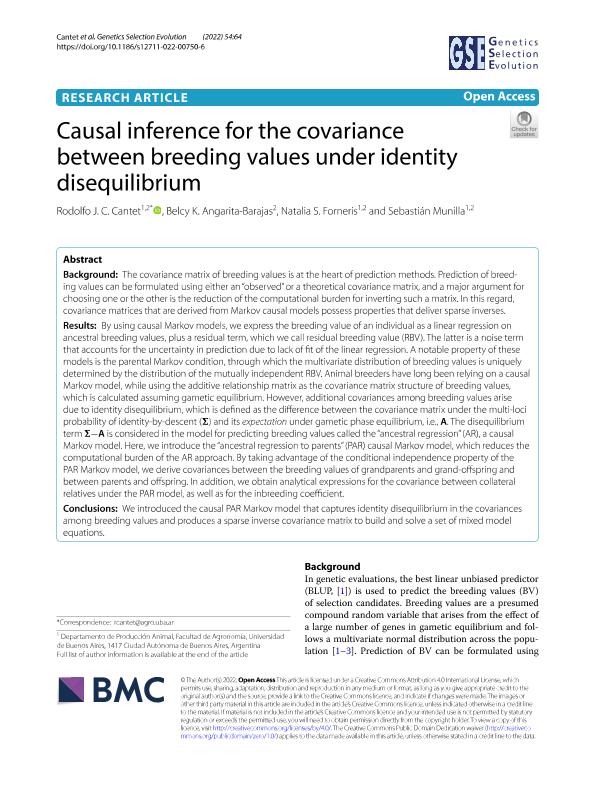Mostrar el registro sencillo del ítem
dc.contributor.author
Cantet, Rodolfo Juan Carlos

dc.contributor.author
Angarita Barajas, Belcy Karine

dc.contributor.author
Forneris, Natalia Soledad

dc.contributor.author
Munilla Leguizamon, Sebastian

dc.date.available
2023-08-15T17:53:28Z
dc.date.issued
2022-12
dc.identifier.citation
Cantet, Rodolfo Juan Carlos; Angarita Barajas, Belcy Karine; Forneris, Natalia Soledad; Munilla Leguizamon, Sebastian; Causal inference for the covariance between breeding values under identity disequilibrium; BioMed Central; Genetics Selection Evolution; 54; 1; 12-2022; 1-14
dc.identifier.issn
1297-9686
dc.identifier.uri
http://hdl.handle.net/11336/208390
dc.description.abstract
Background: The covariance matrix of breeding values is at the heart of prediction methods. Prediction of breeding values can be formulated using either an “observed” or a theoretical covariance matrix, and a major argument for choosing one or the other is the reduction of the computational burden for inverting such a matrix. In this regard, covariance matrices that are derived from Markov causal models possess properties that deliver sparse inverses. Results: By using causal Markov models, we express the breeding value of an individual as a linear regression on ancestral breeding values, plus a residual term, which we call residual breeding value (RBV). The latter is a noise term that accounts for the uncertainty in prediction due to lack of fit of the linear regression. A notable property of these models is the parental Markov condition, through which the multivariate distribution of breeding values is uniquely determined by the distribution of the mutually independent RBV. Animal breeders have long been relying on a causal Markov model, while using the additive relationship matrix as the covariance matrix structure of breeding values, which is calculated assuming gametic equilibrium. However, additional covariances among breeding values arise due to identity disequilibrium, which is defined as the difference between the covariance matrix under the multi-loci probability of identity-by-descent (Σ) and its expectation under gametic phase equilibrium, i.e., A. The disequilibrium term Σ−A is considered in the model for predicting breeding values called the “ancestral regression” (AR), a causal Markov model. Here, we introduce the “ancestral regression to parents” (PAR) causal Markov model, which reduces the computational burden of the AR approach. By taking advantage of the conditional independence property of the PAR Markov model, we derive covariances between the breeding values of grandparents and grand-offspring and between parents and offspring. In addition, we obtain analytical expressions for the covariance between collateral relatives under the PAR model, as well as for the inbreeding coefficient. Conclusions: We introduced the causal PAR Markov model that captures identity disequilibrium in the covariances among breeding values and produces a sparse inverse covariance matrix to build and solve a set of mixed model equations.
dc.format
application/pdf
dc.language.iso
eng
dc.publisher
BioMed Central

dc.rights
info:eu-repo/semantics/openAccess
dc.rights.uri
https://creativecommons.org/licenses/by/2.5/ar/
dc.subject
regresion ancestral
dc.subject
seleccion genomica
dc.subject
desequilibrio gametico
dc.subject
relaciones genomicas
dc.subject.classification
Ciencias Veterinarias

dc.subject.classification
Ciencias Veterinarias

dc.subject.classification
CIENCIAS AGRÍCOLAS

dc.title
Causal inference for the covariance between breeding values under identity disequilibrium
dc.type
info:eu-repo/semantics/article
dc.type
info:ar-repo/semantics/artículo
dc.type
info:eu-repo/semantics/publishedVersion
dc.date.updated
2023-07-08T00:23:46Z
dc.journal.volume
54
dc.journal.number
1
dc.journal.pagination
1-14
dc.journal.pais
Reino Unido

dc.journal.ciudad
Londres
dc.description.fil
Fil: Cantet, Rodolfo Juan Carlos. Consejo Nacional de Investigaciones Científicas y Técnicas. Oficina de Coordinación Administrativa Parque Centenario. Unidad Ejecutora de Investigaciones en Producción Animal. Universidad de Buenos Aires. Facultad de Ciencias Veterinarias. Unidad Ejecutora de Investigaciones en Producción Animal; Argentina
dc.description.fil
Fil: Angarita Barajas, Belcy Karine. Consejo Nacional de Investigaciones Científicas y Técnicas. Oficina de Coordinación Administrativa Parque Centenario. Unidad Ejecutora de Investigaciones en Producción Animal. Universidad de Buenos Aires. Facultad de Ciencias Veterinarias. Unidad Ejecutora de Investigaciones en Producción Animal; Argentina
dc.description.fil
Fil: Forneris, Natalia Soledad. Consejo Nacional de Investigaciones Científicas y Técnicas. Oficina de Coordinación Administrativa Parque Centenario. Unidad Ejecutora de Investigaciones en Producción Animal. Universidad de Buenos Aires. Facultad de Ciencias Veterinarias. Unidad Ejecutora de Investigaciones en Producción Animal; Argentina
dc.description.fil
Fil: Munilla Leguizamon, Sebastian. Consejo Nacional de Investigaciones Científicas y Técnicas. Oficina de Coordinación Administrativa Parque Centenario. Unidad Ejecutora de Investigaciones en Producción Animal. Universidad de Buenos Aires. Facultad de Ciencias Veterinarias. Unidad Ejecutora de Investigaciones en Producción Animal; Argentina
dc.journal.title
Genetics Selection Evolution

dc.relation.alternativeid
info:eu-repo/semantics/altIdentifier/url/https://gsejournal.biomedcentral.com/articles/10.1186/s12711-022-00750-6
dc.relation.alternativeid
info:eu-repo/semantics/altIdentifier/doi/https://doi.org/10.1186/s12711-022-00750-6
Archivos asociados
